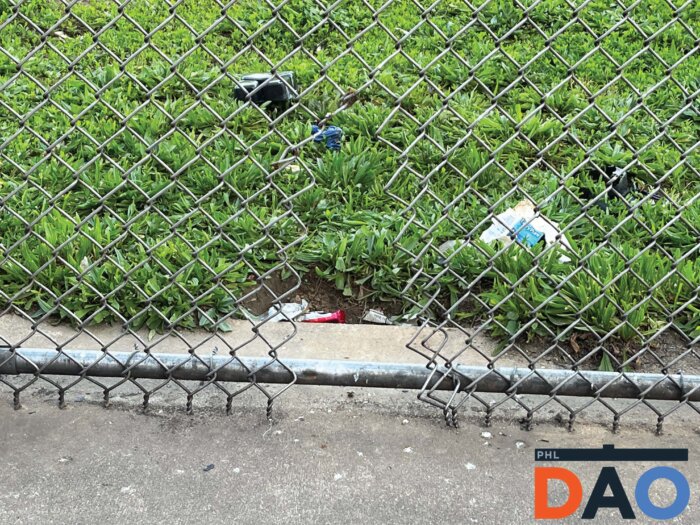In the hours after two men escaped from a State Road prison, a correctional officer periodically woke up from a nap to falsify inmate counts.
Jail personnel knew days before the escape that a hole had been cut in a fence around the recreation yard.
And the pair mounted sensor posts – turned off more than a decade ago after being repeatedly triggered by geese – to clear the perimeter fences.
District Attorney Larry Krasner, speaking at a City Council hearing Wednesday, made those stunning revelations from his office’s investigation into the May 7 escape of Ameen Hurst and Nasir Grant from the Philadelphia Industrial Correctional Center.
Hurst, who has been charged with killing four people, and Grant were recaptured within 10 days of the escape.
Krasner presented Council with three images and video and indicated that he was only scratching the surface of the evidence investigators have uncovered. He said there are 30 to 35 audio and video clips and invited lawmakers to his office to review the case.
“From the bottom of my heart, I invite the mayor,” Krasner said. “I invite the next mayor, the day after Election Day, or as soon as we can figure it out. I invite Council to get together with us so that we can be transparent and show you almost everything we have.”
A picture from surveillance footage showed inmate Jose Flores-Huerta in a common area, near an unmanned guard booth, as one of the escapees crawled out a wide open door to a recreation yard.
The booth was empty because a guard who had been pressed into working a second shift left halfway through, leaving a four-hour gap, Krasner said. That left only a correctional officer behind a tinted window, in charge of keeping an eye on three separate units, he added.
Authorities believe Flores-Huerta acted as a lookout for the two men. He and three civilians have been charged with aiding Hurst and Grant.
In the video clip, the pair can be seen casually leaving their cells in the H1 block. Krasner said another clip, not shown during the hearing, illustrates how they manipulated the doors to remain unlocked.
Hurst and Grant were outside the building within 90 seconds, and they then slipped through an opening the fence that had been made seven weeks prior, according to the DA’s Office.
“We have video indicating that prison personnel actually were aware of this four days before the escape because there’s video showing them out looking at it, pointing at it,” Krasner told Council members.
After scaling one perimeter barrier, they spent 30 minutes in the “dog run,” an area between two fences, Krasner said. The dogs were replaced decades ago with sensor posts, used to detect movement. The devices ended up picking up nearby birds, he said.
“Eventually someone decided to turn them off,” Krasner. “They have been turned off for more than a decade.”
The absence of Hurst and Grant went unnoticed for 19 hours, until a correctional officer overheard other inmates discussing it, prosecutors said.
Footage, Krasner alleged, shows a guard dozing off and entering in a count number without checking the cells. There were at least three incorrect counts, he added.
Krasner, in his testimony, did not blame anyone by name or criticize any specific department, and Councilmember Sharon Vaughn, who sponsored a resolution calling for the hearing, was quick to note that the meeting was “not a witch hunt.”
“There is, to say the least, a lot to unpack there,” Councilmember Curtis Jones Jr. said. “I see mechanical and personnel failures in tremendous proportions.”

Department of Prisons Commissioner Blanche Carney, who also appeared at the hearing, said she replaced the executive staff at PICC in May, but she did not mention any other personnel decisions, citing an ongoing internal investigation.
Her team, she said, has reinforced a policy requiring officers to have their counts double-checked by supervisors, and the department put out a training video instructing guards to push and pull on cell doors to ensure they are locked. Increased focus has also been placed on securing doors to the yard outside of recreation time, according to Carney.
Carney told lawmakers that PDP has removed the inoperable sensor poles, installed additional lighting and cameras, and removed brush from the prison campus in Holmesburg to improve sight lines.
She also pointed to the department’s staffing crisis. The prison system had 867 vacancies, as of last week, Carney said.
She expressed support for reducing the prison population, which has remained static at around 4,700 people over the last several years. The number of inmates totaled more than 8,000 as recently as 2015.
“These escapes are happening more routinely than was previously expected,” Carney said, referring to recent incidents across Pennsylvania and the country. “Corrections, we have been obliterated by the pandemic.”
The jail camera system, she said, is more than 25 years old. Krasner testified that the cameras are rarely monitored live and that finding old segments of video is extremely difficult.
“Commissioner, let us help you,” Vaughn said. “It’s obvious there are some serious malfunctions and things that need to be addressed.”































